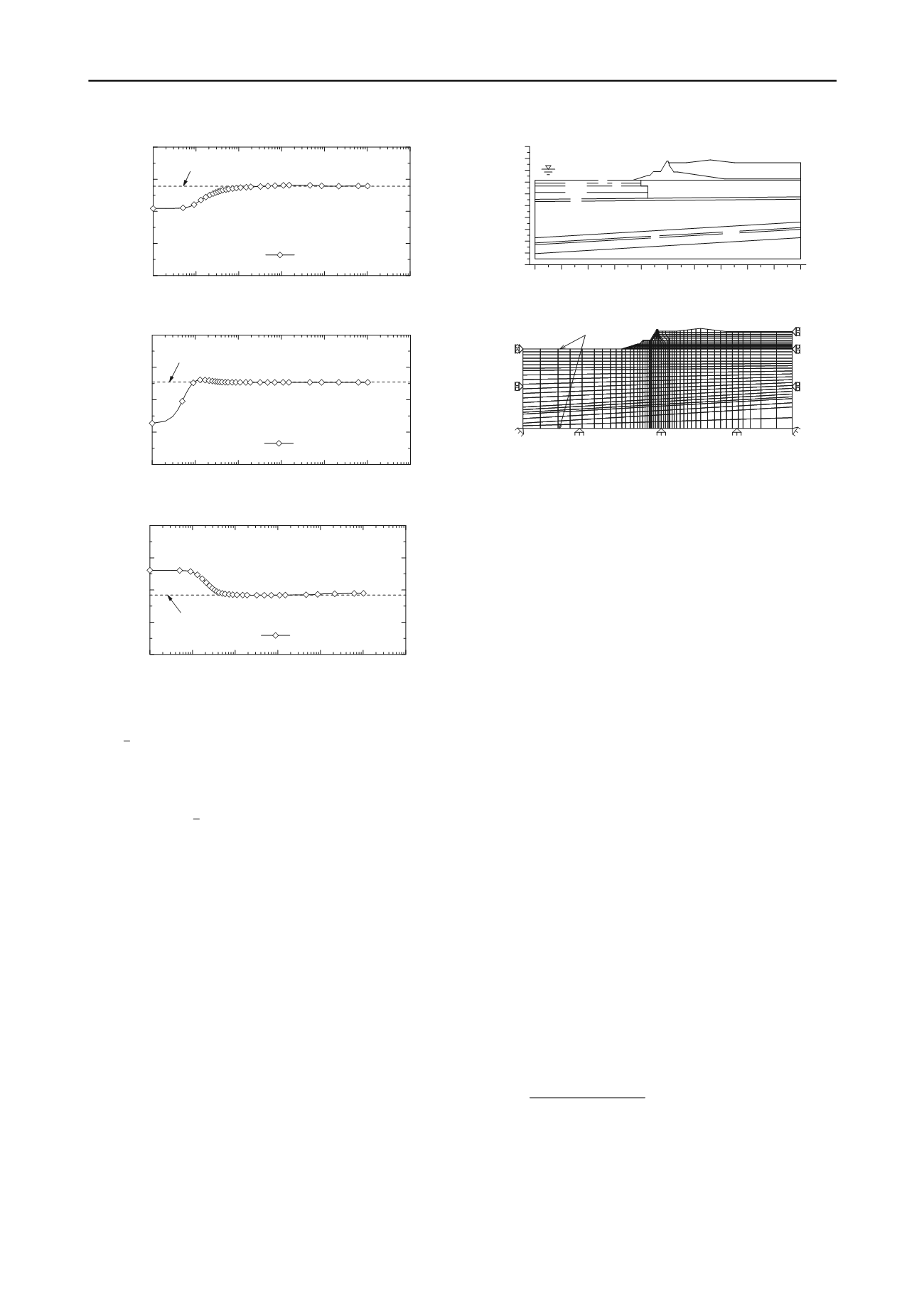
1899
Technical Committee 206 /
Comité technique 206
10
0
10
1
10
2
10
3
10
4
10
5
10
6
0.10
0.15
0.20
0.25
0.30
(a)
: Identified parameter
True value
Elapsed time (min)
Compression index,
10
0
10
1
10
2
10
3
10
4
10
5
10
6
0.04
0.06
0.08
0.10
0.12
(b)
Elapsed time (min)
: Identified parameter
True value
Swelling index,
10
0
10
1
10
2
10
3
10
4
10
5
10
6
0.9
1.0
1.1
1.2
1.3
(c)
: Identified parameter
Elapsed time (min)
True value
Critical state parameter,
Figure 4. Time evolution of identified parameters.
-500
-400 -300
-200
-100
0
100
200
300
400
500
-160
-140
-120
-100
-80
-60
-40
-20
0
20
40
Ac3-2
Ac3-1
Ac2
Ac1
Ds4
(M)
(U)
(L)
Ma12
Asc
Ds1 -Ds3
(Ma13)
Improved ground by sand drains
Land fill
Seawall
K.P. (m)
Distance (m)
Figure 5. Cross section of the construction site (Yamamoto
et al
. 2010).
Permeable
Figure 6. Finite element mesh (Murakami
et al
. 2012).
where
t
and
indicate the identified parameter at time step
t
and the parameter of particle number (
i
) at time step
t
,
respectively.
)(
i
t
The parameter identification of unknown parameters
approaches the true values, although the identification starts
with an incorrect
0
in all cases purposefully. These results
verify the effectiveness of the PF for the parameter
identification of the elasto-plastic model, which presents strong
nonlinear behavior.
4 APPLICATION OF THE PF TO SETTLEMENT
BEHAVIOR OF KOBE AIRPORT ISLAND CONSTRUCTED
ON RECLAIMED LAND
The objective of this chapter is to investigate the applicability of
the PF to an actual settlement prediction of a well-documented
geotechnical construction project, Kobe Airport Island. To
accomplish this objective, firstly, the settlements of the island
are evaluated using a soil-water coupled finite element analysis
with the Cam-clay model. Then, the parameters are identified
using the PF. Finally, comparing the recomputed simulation
using identified parameters with the observation data, the
practical effectiveness of the methodology based on the PF is
discussed. Some outcomes obtained from this application
example were reported in Murakami
et al
. (2012).
Kobe Airport was constructed on an artificially reclaimed
island just off the coast of Kobe. Figure 5 shows the cross
section of the construction site. Vertical sand drains were
installed in the soft clay layer in order to accelerate the
settlement and increase the strength (e.g. Yamamoto
et al
.
2010).
The soil-water coupled finite element analysis with the Cam-
clay model was adopted for analyzing the deformation behavior
of the seawall and the foundation subjected to the construction
and reclamation work. Figure 6 shows the finite element mesh.
In the model ground, the top surface, bottom surface and the
sides of sand/gravel layers were assumed to have permeable
boundary conditions, whereas the sides of clay layers were
assumed to have impermeable boundary conditions. The sand
layers and reclaimed ground were assumed to be linear elastic,
and the clay foundations were represented by the Cam-clay
model.
The
mass permeability
concept, which was proposed by
Asaoka
et al
. (1995), was incorporated into this analysis. Mass
permeability is the permeability representative of a clay
foundation, which includes the effects of inhomogeneity, partial
drainage, and load intensity. We also adopted the concept in the
same sense. The analysis in this chapter focuses on the
settlement behavior of only the improved alluvial clay
foundation, because the soil layers which are just below the
improved ground, called Ds1-Ds3, are thick, have high rigidity
(the N-value obtained from SPT is more than 100), and do not
significantly affect the settlement of the island.
Firstly, we considered the improved ground to be
homogeneous by incorporating the mass permeability concept.
Then, using the PF, some parameters of the treated ground, the
so-called
mass parameter
were identified to simulate settlement
of the ground under the airport island. Although the some
parameters affect settlement of the ground, the compression
index
and the permeability
k
were treated as the only
parameters to be identified, because these two parameters
directly govern consolidation behavior of clay grounds. Finally,
the simulations were implemented using the identified mass
parameters and observation data were compared to evaluate the
practical usability of the PF.
The representative parameters of the improved grounds,
referred to as mass parameter (
P
mass
) in this study, are
determined here by using equation (3) for simplicity.
), ,2,1 (
2 1
32 11
mass
n
i
h
h h
hP hP hP P
n
nn
(3)
where
P
i
,
h
i
, and
n
are the parameters, the thickness of each
layer, and the number of soil layers, respectively.
We conducted Monte Carlo simulations with 200 particles
over the feasible space listed as follows:
0.30
0.60, 1×10
-0
k
1×10
-3
. (4)


